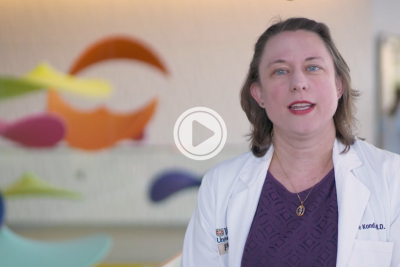As a pediatric oncologist, one of the hardest parts of the job is to tell a parent their child, who may otherwise be perfectly healthy, now has cancer. While there are many, many different types of pediatric cancer and each diagnosis comes with its own treatment plan and outcomes, I frequently hear parents react to a cancer diagnosis with: “What did we miss?”, “If this was caught earlier, would things be different?”, “Is there something we did wrong to cause this?”. Almost always, my responses are: the signs and symptoms of cancer can be very hard to pick up – even for the medical professional; the biology of this cancer does not change if it was caught last week versus today; and no, you did absolutely nothing wrong.
Risk of Pediatric Cancer Development
In pediatrics, about 10% of cancers can be attributed to genetic mutations but the vast majority develop spontaneously, meaning you as a parent wouldn’t know to think about this possibility in your child. For those children who do have a risk of developing cancers, sometimes we do not know that risk exists until an initial cancer develops. But in general, the overwhelming majority of children will never receive a cancer diagnosis. In 2021, it is estimated nearly 16,000 children and adolescents were diagnosed with cancer in the United States – in comparison to a population of over 77 million children.
Signs and Symptoms of Cancer
Leukemia
The presenting signs and symptoms of cancer depends on where it is located in the body. Leukemia is the most frequently diagnosed cancer in pediatrics. It is a cancer of white blood cells in the bone marrow, the blood-making factory of the body. When too many of the ‘bad’ cancer cells are produced, not enough of the other blood cells are made. This leads to symptoms associated with having low platelets, low hemoglobin and not enough infection-fighting cells.
As a result, you can see more bruises or see little red dots on the skin called petechiae (a sign of low platelets). Your child may also bleed easier and the skin may appear paler with your child having decreased energy (a sign of low hemoglobin). Your child may also be more prone to infections. We also see recurrent fevers and signs of bone pain as the pressure in the bone marrow expands, with some children limping or saying their joints, hips, or extremities hurt.
Brain Cancer
Alternatively, if a tumor were to develop in the central nervous system, the next most common site of disease, a child or adolescent would present with signs and symptoms related to increased pressure in the brain or issues related to spinal cord involvement. Headaches, while often not a sign of cancer, are commonly seen in those who develop brain tumors. Usually, the pain is most intense first thing in the morning and sometimes wakes children from sleep, and can additionally be associated with vomiting.
Other warning signs can be an increase in sleepiness or lethargy, change in behavior/personality, difficulty walking – seeming clumsier with an increase in falls, or issues with movements or sensation of parts of the body. In infants, before the skull bone is fused or completely closed, one may see an increase in head size or abnormal bulging of part of the head. Lastly, sudden changes in vision, hearing or speech or even new onset seizures can be associated with brain tumors.
Lymphoma
Lymphomas are the third most common type of cancer seen in the pediatric population – and their location, which comes from an origination in the lymphatic system, can exist throughout the body. If an external lymph node is involved, you may notice a painless mass in the neck, groin or armpit. Persistent fatigue, fevers, night sweats (where the sheets are literally drenched), and unintentional weight loss are other common symptoms. Itchiness of the skin and being short of breath can also be seen.
Detectable Masses
Lastly, there are a variety of other ‘solid’ tumors outside of the brain and spinal cord that are more commonly seen in children and adolescents. Bone tumors, such as osteosarcoma or Ewing sarcoma, usually present in adolescents with focal bone pain and potential swelling. Wilms tumor, a type of kidney cancer, or hepatoblastoma, a type of liver cancer, can first be detected by parents in younger children when they feel a mass in the belly or note a distended abdomen. Other symptoms of abdominal or pelvic masses can include constipation, fussiness, diminished appetite, or change in how the child walks.
Rhabdomyosarcoma, the most common soft tissue sarcoma in children, can be located anywhere throughout the body and sometimes presents as a mass you can see – including around the eye, on the face or neck, or even on an extremity. And retinoblastoma, an eye cancer that begins in the retina, can be first detected in infants and very young children when a white color is seen in the center of the eye when light is shone – such as when someone takes a picture with a flash.
What Do I Do If I Am Concerned My Child Has Cancer?
As a parent, you are your child’s biggest advocate. If you feel that something is ‘off’ at home, the first step is being seen by your child’s pediatrician. If you feel that your child’s health is at immediate risk, you should have them evaluated in an emergency department (and call 911 if you need instant attention). Make sure your voice is heard, and you are able to communicate your concerns. The medical provider may choose to do an initial workup with labs or imaging tests, or may want you to continue to monitor symptoms at home and have you return if concerns persist. Trust your gut! If something still seems wrong and you don’t have answers, please return for evaluation.
What to Do If Your Child Receives a Cancer Diagnosis
Information, in the beginning, will seem (and is!) very overwhelming; I recommend that patients and parents record questions that may arise and know that we expect to review concepts multiple times to ensure understanding. No question is a bad question, and I encourage you to work with your oncologist until you feel comfortable with the proposed treatment approach. In some cases, you may feel more comfortable obtaining a “second opinion,” which means another institution would review and confirm your child’s diagnosis and provide thoughts towards potential therapy plans. These consultations sometimes occur after treatment has started as well. We are always happy and welcome any parent or outside institution who requests our evaluation
What to Expect If Your Child Has Cancer
The treatment approach and overall outcomes will largely depend on the type of cancer and its location in the body. You and your family will meet with a pediatric hematologist/oncologist, a pediatrician who has received further education and training in treating blood and cancer disorders, who will guide you through the next immediate and potential long-term steps.
At some institutions, including St. Louis Children’s Hospital, pediatric oncologists further subspecialize into types of cancer (i.e. brain, leukemia, solid tumor), and your child would ultimately be paired with a physician who is well versed in state-of-the-art evaluations and treatments for your child’s particular cancer diagnosis. Very commonly, more tests will be done to locate all sites of disease and come up with the best therapy plan. Basic approaches to eradicate cancer cells can include chemotherapy, targeted therapies, surgery, and radiation and will be tailored to the type of cancer and known genetic mutations.
At this point in time, over 80% of children and adolescents who are diagnosed with cancer will be cured. Long-term toxicities can exist due to the type of treatments used, and your child will require close monitoring after the conclusion of therapy, even when ‘cancer-free.’ The journey of a pediatric cancer patient can be full of challenges and will inevitably take emotional and physical tolls on both patients and families – our job is to create the village to support all parts of this journey, to be realistic while maintaining optimism, and to ensure you truly know you and your child are never alone in this fight.






Comments